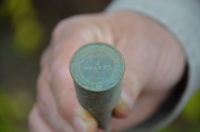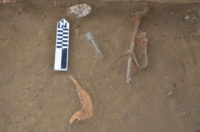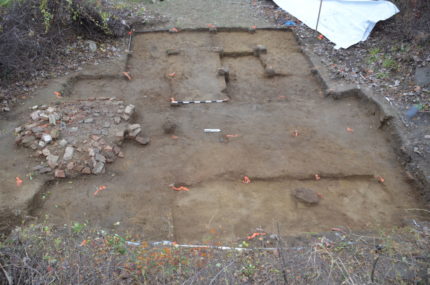 Archaeologists have discovered an 18th century field writing kit at the site of a British fort on Rogers Island, in northeastern New York. The writing kit is made of brass and consists of an ink pot and long quill holder. The word “Barker” is etched on the base of the writing implement, the mark of a German company that manufactured writing tools for centuries.
Archaeologists have discovered an 18th century field writing kit at the site of a British fort on Rogers Island, in northeastern New York. The writing kit is made of brass and consists of an ink pot and long quill holder. The word “Barker” is etched on the base of the writing implement, the mark of a German company that manufactured writing tools for centuries.
Rogers Island, located at a strategically significant bend of the Hudson River that was the portage site between the Hudson River and Lake Champlain, was part of the Fort Edward complex built by the British in the 1750s during the French and Indian War. It was a staging area for incursions into New France and from 1756 to 1759, was used by Major Robert Rogers has the base camp for a company of irregular troops. His 28 “Rules of Ranging” combined guerrilla and traditional warfare with Rogers’ own unique concepts to create a rugged, versatile fighting force adapted to the terrain. Rogers’ Rangers are considered the ancestors of today’s United States Army Rangers.
Fort Edward was evacuated in 1766 and the structures abandoned. By the time of the Revolutionary War, the fort was a dilapidated ruin, but the barracks that were still standing were used by Continental soldiers until General Burgoyne took the fort on his way to ultimate defeat in Saratoga. Some homes were built on the island in the 19th century and it saw its last use in the training of troops during the Civil War.
It was during Rogers’ time that barracks, a blockhouse, Ranger huts, a smallpox hospital and the officers house were built.
“We have never found a beautiful brass writing implement in any of our excavations,” [lead archaeologist David] Starbuck said in a phone interview Tuesday. “That, to me, says literate people were inside that building.” The items are more evidence to tell the story of the French and Indian War site that once housed British officers. Starbuck said he is still unsure if the house held one high-ranking officer or several.
 The writing kit isn’t the only unique find this year. The team also unearthed a lead ingot, likely destined to be melted down for musket balls, and a metal fireplace spit. Some of the other items found on Rogers Island include the head of a broad axe, and cuff links. Butchered animal bones were also found in the officers house.
The writing kit isn’t the only unique find this year. The team also unearthed a lead ingot, likely destined to be melted down for musket balls, and a metal fireplace spit. Some of the other items found on Rogers Island include the head of a broad axe, and cuff links. Butchered animal bones were also found in the officers house.
The animal bones and spit indicate the officers (or officer) ate fresh meat, unlike common soldiers, who would have eaten dried beef or pork, “which would have tasted awful,” Starbuck said.
Based on where things were found, Starbuck believes the hut originally had a dirt floor. He said “lots of things were walked on and pressed into the floor. Later they built a wood floor, which is now totally gone.”
